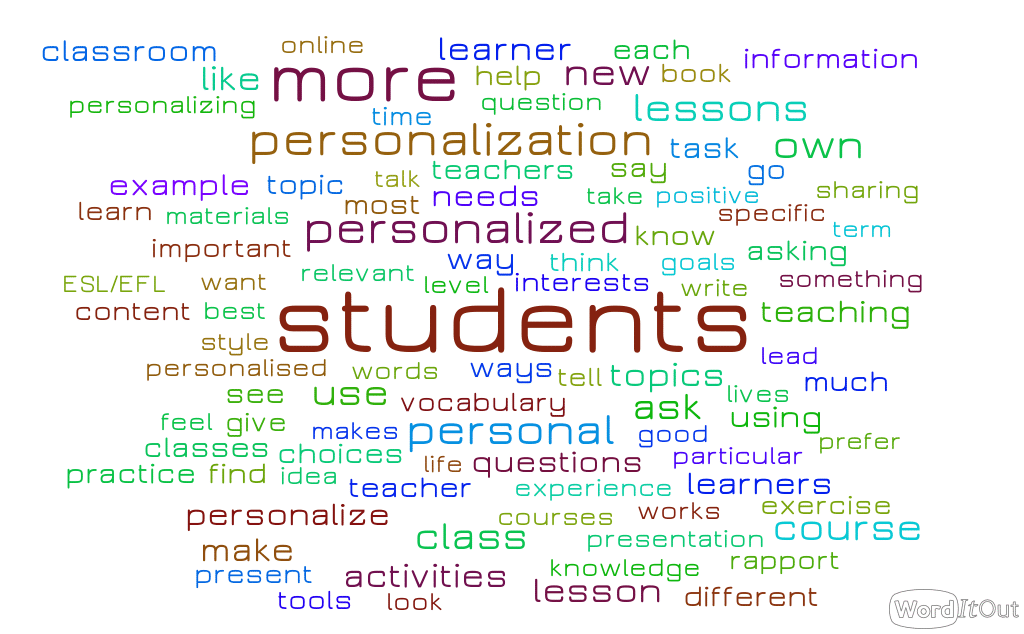P is for Personalization and Private one-to-one lessons. But what about larger groups?
A long time ago, I wrote a blog post here talking about the perks and perils of being a private teacher. At that time, I had been teaching private classes for just one year. I have mostly taught one-to-one lessons since 2017, even though I have now been a private teacher for 10 years. Although I have focused on planning classes and catering for all my students’ needs, I haven’t read much about it. Then, last year, in my Celta interview, I was asked to talk a little about personalizing classes. I realized shortly thereafter that I had heard about personalization before. Yet never had I noticed that was exactly what I had been doing for so long.
Then again, I came across a session on personalizing materials for learners while attending a conference on Academic English last week. During the session, the guest speaker mentioned several different ways in which he personalizes his classes, which really got me thinking. I wholeheartedly believe personalization happens naturally when teaching either one-to-one classes or very small groups. But what about larger groups?
First of all, it is crucial that we understand what personalization really means in regard to TEFL. In the article Speaking matters: Personalization, Adrian Tennant states that “By ‘personalization’ we don’t simply mean talking about what students like or want to talk about, although that is certainly one form of personalization. What we mean by personalization is taking any topic that you might have as the theme of your class or find in the coursebook you are using, and getting students to look at it from a personal viewpoint. This can take a number of different forms – from making statements true for you or discussing questions with ‘you’ as the subject, to telling a personal story or anecdote connected to the topic”.
Similarly, Sue Swift declares that “Personalisation activities are activities which focus on the learners themselves, their own experiences and opinions rather than topics in the abstract. They became popular, and started to be built into Communicative Language Teaching, with the rise of the Humanistic Approach, which emphasised the role of positive affect on learning”.
All in all, personalization is largely assumed to be good for language learning as it helps create rapport, motivate learners, increase engagement as well as active students’ schemata. Teachers may tailor their classes by
– conducting a needs analysis interview and/or questionnaire, that is, by finding out as much as they can about students from day one
– understanding how students prefer to learn and using the most effective study materials
– remembering details about students (whether they like comedies or love stories)
– personalizing course books if they happen to be using one
– asking students to choose the topics they would like to talk about
– personalizing language practice while working on a specific grammar topic or while working on vocabulary, that is, by customizing tasks and activities
– allowing space for students’ anecdotes,
– using digital tools, that is, by asking students to take their own photos so that they can be used in class, by creating their own videos, as well.
Although this may be true, I still wonder how we teachers have the time to put all these aspects into practice while teaching larger groups. Therefore, I would like to hear as much as possible from you if you do so.
References:
Dodgson, D. Defining personalization. Available at https://www.teachingenglish.org.uk/professional-development/teachers/understanding-learners/magazine/david-dodgson-defining. Last accessed on February 12, 2023.
Hughes, J. 10 ways to personalize your lessons. Available at https://www.myetpedia.com/how-to-personalize-lessons. Last accessed on February 12, 2023.
Hughes, J. PERSONALIZATION IN THE ELT CLASSROOM. Available at https://infocus.eltngl.com/2017/09/19/personalization-in-the-elt-classroom/. Last accessed on February 12, 2023.
Kerr, P. (2016). Personalization of language learning through adaptive technology: Part of the Cambridge Papers in ELT series. [pdf] Cambridge: Cambridge University Press. Available at https://www.cambridge.org/elt/blog/wp-content/uploads/2017/06/CambridgePapersinELT_AdaptiveLearning.pdf. Last accessed on February 12, 2023.
Kerr, P. Evaluating personalization. Available at https://adaptivelearninginelt.wordpress.com/2017/07/20/evaluating-personalization/. Last accessed on February 12, 2023.
Kerr, P. Personalized learning: the past, present and future of ELT. Available at www.trinitycollege.com/resource/?id=8438. Last accessed on February 12th, 2023.
Nuñes, K. L. How to Personalize Your English Lessons: 7 Effective Strategies. Available at https://bridge.edu/tefl/blog/how-to-personalize-your-english-lessons. Last accessed on February 12, 2023.
Swift, S. An ELT Glossary: Personalisation Activities. Available at http://eltnotebook.blogspot.com/2017/06/an-elt-notebook-personalisation.html. Last accessed on February 12, 2023.
Tennant, A. Speaking matters: Personalization. Available at https://www.onestopenglish.com/support-for-teaching-speaking/speaking-matters-personalization/154289.article. Last accessed on February 12, 2023.
Thornbury, S. P is for Personalization. Available at https://scottthornbury.wordpress.com/2012/02/12/p-is-for-personalization/. Last accessed on February 12, 2023.
_______________
Main image created at https://worditout.com/.






